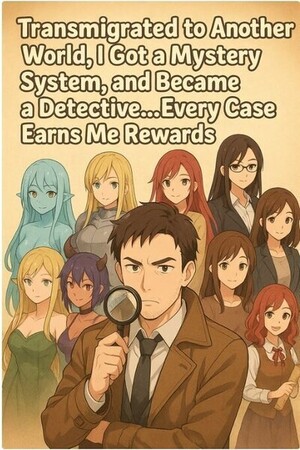Chapter 17:
The Forge... of Romance?
Earthly Solutions
Three days after our initial meeting, Selena Brightforge arrived at our office with a detailed response to our partnership proposal that was easily the most thorough business analysis I'd ever seen from someone outside the accounting profession.
"Gentlemen," she said, settling into the chair across from our conference table with the same focused precision she applied to everything else, "I've reviewed your specifications, run cost analyses on your volume projections, and evaluated the operational implications of your proposed collaboration."
Mr. Tanaka immediately leaned forward with the expression of someone about to receive the results of a particularly important examination. "And your assessment?"
"Your proposal is sound," she said simply. "The volume commitments justify the pricing structures you're requesting, the standardization requirements are achievable within my current production capabilities, and the inventory management integration would actually improve my operational efficiency."
I felt a surge of relief and excitement. "You're interested in moving forward?"
"More than interested. I'm impressed." She pulled out what appeared to be her own detailed business plan. "But I have some modifications and additional suggestions that could benefit both our organizations."
Over the next hour, Selena walked us through her analysis with the kind of systematic thoroughness that made Mr. Tanaka's documentation standards look casual by comparison. She had calculated optimal production schedules, identified opportunities for process improvements, and developed quality assurance protocols that would ensure consistent performance characteristics across all equipment categories.
"The key insight," she explained, showing us detailed technical specifications, "is that standardization doesn't mean reducing quality—it means systematizing excellence so that premium results become predictable and repeatable."
"That's exactly what we've been trying to achieve with our financial optimization services," I said, recognizing the parallel approach. "Taking superior methods and making them accessible through systematic implementation."
"Precisely. Which is why I think this partnership could extend beyond just equipment procurement."
Mr. Tanaka looked up from his notes. "How so?"
"Your approach to financial optimization and my approach to metallurgical excellence are based on the same fundamental principle: that superior results come from superior processes, consistently applied." Selena spread out what appeared to be organizational charts and workflow diagrams. "What if we could demonstrate that principle across multiple aspects of adventuring economics?"
I was beginning to see where she was going with this. "You're suggesting expanded collaboration?"
"I'm suggesting that we could serve as a model for how professional excellence in different fields can be integrated to create value that exceeds the sum of its parts."
The conversation continued for another two hours, and by the end of it, we had developed what amounted to a comprehensive business alliance that went far beyond our original equipment procurement proposal. Selena would provide standardized, premium equipment with guaranteed performance characteristics. We would provide financial optimization and supply chain management services. Together, we would demonstrate how systematic professional excellence could revolutionize the entire adventuring economy.
But more than the business implications, I found myself genuinely impressed by Selena's approach to problem-solving. She brought the same methodical precision to strategic planning that she clearly applied to metallurgy, combined with a creative intelligence that identified opportunities I would never have considered.
"Miss Brightforge," I said as our meeting concluded, "this has been one of the most productive business development discussions I've ever participated in."
"Please, call me Selena. And I agree—it's rare to find people who understand that true efficiency comes from doing things correctly rather than just doing them quickly."
As she gathered her materials and prepared to leave, I realized that our business partnership was going to be built on something more substantial than just mutual commercial benefit. We shared a genuine appreciation for professional excellence and systematic approaches to complex challenges.
"Selena," I said, "would you be interested in continuing our collaboration discussions over dinner? There are some additional integration opportunities I'd like to explore."
She paused in organizing her papers and looked at me with an expression that suggested she was evaluating this suggestion with the same analytical attention she applied to business proposals.
"Professional consultation or personal invitation?" she asked directly.
"Both," I admitted. "I'm genuinely interested in your perspective on optimization strategies, but I'm also finding that I enjoy working with someone who approaches their profession with such dedication and competence."
"I appreciate honesty." She finished organizing her papers and stood up. "Yes, I'd be interested in continuing our discussions. But I should warn you—I tend to approach personal relationships with the same systematic attention I apply to professional challenges."
"That sounds perfect to me."
Over the following week, Selena and I began what could only be described as the most methodical courtship in the history of romantic relationships. Our dinner conversations covered everything from metallurgical theory to financial optimization strategies, from supply chain logistics to quality assurance protocols.
But beneath the professional discussions, I was discovering someone whose approach to life reflected the same values that I was finding so satisfying in our business development work. Selena was someone who believed that excellence was achieved through systematic effort, that problems were solved through careful analysis, and that the most rewarding achievements came from doing difficult things correctly rather than easy things carelessly.
"You know," she said during one of our evening consultations, "most people who try to court me either completely ignore my professional accomplishments or treat them as some kind of amusing novelty."
"That's their loss," I said. "Your professional competence is one of the most attractive things about you."
"Most people find it intimidating."
"Most people probably feel threatened by someone who's demonstrably better at their job than they are at theirs." I paused, considering how to articulate what I was thinking. "But I find it inspiring. You've achieved something I respect—genuine mastery of a complex, demanding profession."
"And you've achieved something I respect," she replied. "You've taken skills that most people dismiss as boring bureaucracy and used them to genuinely improve people's lives."
It was perhaps the most romantic conversation I'd ever had, despite the fact that we were discussing comparative professional methodologies.
Our business integration proceeded with equal success. Selena's equipment standardization program was providing our clients with predictable, high-quality gear that dramatically improved their financial planning capabilities. Our volume commitments were allowing her to optimize her production scheduling and negotiate better pricing for raw materials. The collaboration was generating benefits for everyone involved.
But more importantly, Selena and I were discovering that our professional partnership was becoming something deeper. We shared an appreciation for systematic excellence, a commitment to continuous improvement, and a belief that the most satisfying work came from solving complex problems that made a meaningful difference.
"Hiroshi," Selena said one evening as we reviewed the latest client satisfaction reports, "I think we've created something significant here."
"The business partnership?"
"The business partnership, yes. But also..." She paused, looking at the data with an expression that suggested she was evaluating possibilities. "Also a personal relationship based on genuine mutual respect and shared values."
I looked at her, noting the way she approached even emotional conversations with the same thoughtful precision she applied to everything else.
"Selena," I said, "I think you're right. And I think it's exactly what both of us have been looking for, even if we didn't realize it."
"A partnership between equals who challenge each other to be better at what they do best?"
"Exactly."
It was around this time that our success began attracting attention from less positive sources. The systematic improvements we were generating for our clients, combined with Selena's equipment standardization program, were beginning to stabilize the local adventuring economy in ways that made some people uncomfortable.
Specifically, people who had been profiting from the chaos and inefficiency that we were systematically eliminating.
"Hiroshi," Mr. Tanaka said during one of our weekly business reviews, "we may have a problem. Finn's surveillance reports indicate that someone's been asking questions about our operations—not potential clients, but someone conducting what appears to be competitive intelligence gathering."
"What kind of questions?"
"Details about our client base, our service methodologies, our financial arrangements with local merchants and suppliers." He consulted his notes. "Professional interest would focus on results and general approaches. This sounds more like someone looking for vulnerabilities or ways to disrupt our operations."
Selena, who had been reviewing equipment production schedules, looked up with obvious concern. "Any idea who's conducting this investigation?"
"Finn thinks it might be connected to Guild Leader Malachar," Mr. Tanaka said. "Someone whose business model depends on adventurers remaining financially disorganized and dependent on guild services for basic operational support."
I felt a chill of recognition. We'd been so focused on building our business and serving our clients that we hadn't considered how our success might threaten people whose livelihood depended on the problems we were solving.
"So our systematic approach to improving adventuring economics has attracted the attention of someone who profits from economic chaos?"
"That appears to be the situation," Mr. Tanaka confirmed grimly.
Selena was already making notes, her expression shifting into the focused intensity she displayed when confronting technical challenges.
"Then we need to prepare for the possibility that our business success has made us a target for someone who sees our improvements as a threat to their interests."
I looked around our office, with its organized filing systems, satisfied client testimonials, and evidence of the meaningful work we'd been doing, and realized that our interdimensional entrepreneurship adventure was about to become significantly more complicated.
Apparently, revolutionizing medieval economics came with some risks we hadn't anticipated.




Please sign in to leave a comment.